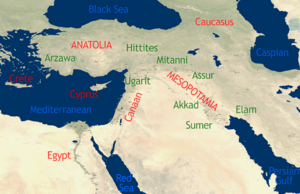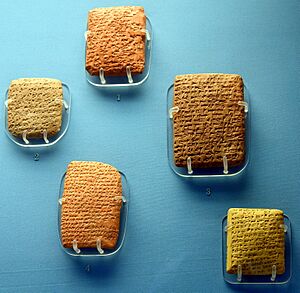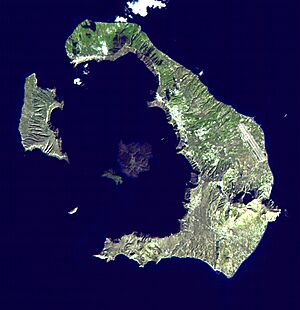Chronology of the ancient Near East facts for kids
Imagine trying to figure out exactly when everything happened thousands of years ago! That's what the chronology of the ancient Near East is all about. It's like a giant timeline that helps us understand when important events, kings, and kingdoms existed in places like Mesopotamia (modern-day Iraq) and the Levant (modern-day Israel, Lebanon, Syria, Jordan).
Ancient people often recorded events by saying "in the year X of King Y." By comparing many of these records, historians can piece together a "relative chronology." This means they know who came after whom, even if they don't have exact calendar dates. For the very old times, like the 3rd millennium BC (3000-2001 BC) and 2nd millennium BC (2000-1001 BC), figuring out exact dates is tricky.
Here's how historians break down these ancient times:
- Early Bronze Age: This period saw the rise of writing. But finding exact dates for rulers from this time is hard. It's like trying to put together a puzzle with many missing pieces!
- Middle Bronze Age: Around 2300 BC, with the Akkadian Empire, the timeline becomes clearer. We start to see how events in Mesopotamia connect with those in the Levant and even Ancient Egypt. Historians use clues like events in the sky, tree rings, and radiocarbon dating to try and set exact dates. However, they still don't fully agree. The most common idea is that King Hammurabi ruled from 1792 to 1750 BC.
- Late Bronze Age: After a period of confusion, things became more stable. Powerful kingdoms like the Assyrians, Hittites, and Babylonians rose.
- The Bronze Age Collapse: Around 1200 BC, many big kingdoms fell apart. This was a "Dark Age" with invasions and chaos.
- Early Iron Age: By 900 BC, written records became common again, especially with the rise of the Neo-Assyrian Empire. This helped historians set more exact dates. An important clue was an eclipse of the sun mentioned in Assyrian records, which happened on June 15, 763 BC. This helps tie the ancient timelines to our modern calendar.
Contents
Why are Ancient Dates So Hard to Pin Down?
Figuring out exact dates for the Middle Bronze Age is tough because there aren't many clear records. It's like having a "floating timeline" that isn't connected to our modern calendar.
Historians have tried to use things like eclipses or tree rings to fix these dates, but there's no single answer everyone agrees on.
Different Ideas for Middle Bronze Age Dates
The main reason for different dates comes from ancient records about the planet Venus. These records, found on a tablet called the Venus tablet of Ammisaduqa, describe Venus's movements. Since Venus's cycle repeats every eight years, different starting points can lead to different timelines.
Here are some of the main ideas for when the city of Babylon was attacked and fell:
- Long Chronology: Babylon fell in 1651 BC.
- Middle Chronology: Babylon fell in 1595 BC (this is the most common idea).
- Middle Low Chronology: Babylon fell in 1587 BC.
- Short Chronology: Babylon fell in 1531 BC.
- Ultra Short Chronology: Babylon fell in 1499 BC.
This table shows how these different ideas change the dates for key events:
| Chronology | Ammisaduqa year 8 | Reign of Hammurabi | Sack of Babylon | Difference |
|---|---|---|---|---|
| Ultra-Low | 1542 BC | 1696–1654 BC | 1499 BC | 96 years earlier |
| Short or Low | 1574 BC | 1728–1686 BC | 1531 BC | 64 years earlier |
| Middle Low | 1630 BC | 1784–1742 BC | 1587 BC | 8 years earlier |
| Middle | 1638 BC | 1792–1750 BC | 1595 BC | No difference |
| Long or High | 1694 BC | 1848–1806 BC | 1651 BC | 56 years later |
How Do We Find These Dates?
Historians use many different clues to build the ancient timeline.
Clues from the Sky (Astronomical)
Ancient people watched the sky closely. Records of planets and eclipses can be very helpful.
Venus Tablet of Ammisaduqa
This ancient tablet records the movements of the planet Venus during the reign of King Ammisaduqa of Babylon. It describes when Venus appeared and disappeared. Because Venus's movements are predictable, historians can use these records to try and pinpoint exact dates. For example, it might help decide if King Hammurabi started ruling in 1848 BC, 1792 BC, or 1736 BC.
Eclipses
Ancient texts sometimes mention solar or lunar eclipses. If historians can match an ancient eclipse record to a known eclipse date, it helps fix the timeline.
- Nineveh Eclipse: An Assyrian record mentions a solar eclipse in the month of Simanu. This event is strongly believed to be the eclipse on June 15, 763 BC. This is a very important fixed point for the timeline.
- Mursili's Eclipse: A Hittite text mentions the "Sungod gave a sign" during the 10th year of King Mursili II. This might have been an eclipse, but its exact date is still debated.
Written Records (Inscriptional)
Thousands of clay tablets and inscriptions have been found. These are the main source of information for ancient history.
King Lists
Ancient kingdoms often kept lists of their rulers. These lists are like a historical record of who ruled when.
- Sumerian King List:
This list covers rulers in Mesopotamia from before a great flood until later dynasties. It's useful for later periods, but historians use it carefully for the very early times because it sometimes leaves out important kings.
- Babylonian King List: This list focuses only on the kings of Babylon. It helps us understand the rulers of the Kassite dynasty and other periods.
- Assyrian King List: This list goes back to King Shamshi-Adad I (around 1800 BC) and continues for many centuries. It helps create a story of how Assyrian kingship continued over time.
Chronicles
Many ancient chronicles (historical accounts) have been found. They are often broken or have a political bias, but they provide a lot of information when combined with other sources.
- The Babylonian Chronicles are a good example. They tell us about Babylonian kings and events.
- The Synchronistic Chronicle records how the Assyrian and Babylonian empires interacted.
Royal Inscriptions
Ancient kings loved to show off their achievements! They would put inscriptions on temples, buildings, and statues to take credit for battles won, new titles, or pleasing the gods. These inscriptions are very helpful for tracking a king's reign.
Year Lists
Instead of using a calendar like ours, ancient people often named each year after an important event or the king's reign. For example, "the 5th year in the reign of Hammurabi" or "the year Ur was defeated." Compilations of these year names are called date lists.
Eponym (Limmu) Lists
In Assyria, a special official called a limmū was chosen each year. Lists of these officials have been found. They are very accurate for dating events back to about 1133 BC.
Trade and Diplomatic Records
Everyday records, like trade agreements or letters between kings, give us a great look into ancient life. Clay tablets were used for everything from grocery lists to important diplomatic messages.
- Amarna Letters:
These letters were found in Egypt, at the city of Pharaoh Akhenaten. They are mostly in Akkadian, which was the international language of the time. They include letters from kings of Assyria, Babylon, and other smaller states. These letters help us connect the timelines of different kingdoms.
Classical Sources
Some later Greek and Roman writers also wrote about the ancient Near East.
- Berossus: A Babylonian historian who lived around the time of Alexander the Great. He wrote a history of Babylon, and parts of it have survived through other writers.
- Canon of Ptolemy: This book lists kings starting with the Neo-Babylonian Empire. It's mostly accurate and helps us date events from 747 BC onwards.
- Hebrew Bible: The Hebrew Bible (Old Testament) mentions kings and events in the Near East, especially in the Levant. For example, it mentions Pharaoh Necho II and Babylonian kings like Nebuchadnezzar II.
Scientific Dating Methods
Dendrochronology (Tree Rings)
Dendrochronology uses the growth patterns in tree rings to build timelines. While there isn't a continuous tree-ring timeline for the whole Near East yet, scientists are working on it, especially for trees in Anatolia (modern-day Turkey).
Radiocarbon Dating
Radiocarbon dating measures the amount of carbon-14 in ancient organic materials (like wood or bone) to estimate their age. This method often suggests dates that are a bit older than what archaeologists first thought. For example, radiocarbon dates from the city of Ebla seem to support the "Middle Chronology" for the fall of Babylon (around 1595 BC).
Other new dating methods include luminescence dating and archaeomagnetic dating.
Connecting the Timelines (Synchronisms)
Historians look for events that involve two or more different kingdoms. If they can date an event in one kingdom, they can then date it in the other.
Egypt
Egyptian chronology is very important because Egypt often interacted with the Near East.
- Battle of Kadesh: This famous battle involved Ramses II of Egypt and Muwatalli II of the Hittite Empire. It happened around May 12, 1274 BC. Both Egyptian and Hittite records describe it.
- Peace Treaty: A peace treaty between Ramses II and the Hittite king Hattusili III around 1259 BC also helps connect their timelines.
- Amarna Letters: As mentioned before, these letters show Egyptian pharaohs like Amenhotep III and Akhenaten communicating with kings from Babylon, Mitanni, and Assyria.
However, Egyptian chronology also has some tricky periods, especially the "Intermediate Periods" when there was less clear rule. This means that if there are problems in the Egyptian timeline, those problems can affect the timelines of other regions that relied on Egypt.
Indus Valley
There's evidence that the Indus Valley Civilisation (in modern-day Pakistan and India) traded with the Near East during the Bronze Age. Finding their seals and goods in places like Ur helps connect their timelines.
Thera and Eastern Mediterranean
The huge eruption of the Thera volcano (modern-day Santorini, Greece) is another possible marker. This eruption sent ash over Anatolia and pumice (light volcanic rock) into the sea. This pumice even reached Egypt through trade. Scientists have used radiocarbon dating and tree rings to suggest the eruption happened between 1627 BC and 1600 BC. If historians can link this eruption to a specific event in the Near East, it could help fix the "floating timeline" of the Middle Bronze Age.
Images for kids
See also
- Egyptian chronology
- Minoan chronology
- List of Mesopotamian dynasties
- List of rulers of Elam
- List of Neo-Hittite kings
- List of kings of Ebla
- List of kings of Mari











